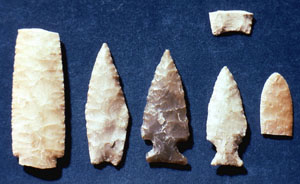Buckner Ranch
Buckner Ranch is a paleontological and archeological locality in Bee County, Texas, near its boundary with Goliad County. There a deep terrace with deposits dating from the Late Pleistocene into the Holocene geologic periods runs along the stream valley that holds two parallel creeks, Blanco Creek and Medio Creek. Named the Berclair Terrace by geologist Glen L. Evans, the valley-fill deposits vary from 10-25 feet in thickness, depending on the location in various part of the stream valley.
Fossil Ice-age animal remains were exposed in 1936 by paleontologists from the Texas Memorial Museum at the University of Texas. In subsequent visits to the Berclair Terrace, museum director E. H. Sellards and his staff recorded 16 sites, most being paleontological deposits yielding mammoth, mastodon, horse, bison and a variety of smaller fauna. During 1938-1939, excavations were done there as a WPA (Works Progress Administration) project. This work was directed by Glen L. Evans, Adolph Witte and Nolan McWhirter. The focus was on Site 1, on the right bluff of Blanco Creek. This site was later designated as 41BE2, the Buckner Ranch site.
These excavations were very carefully controlled, neatly done, and good records were kept on horizontal provenience. Vertical provenience, however, was not fully recorded, not unlike contemporary WPA archeological excavations at the Morhiss Mound site (see Morhiss exhibit LINK). There was a concentration of Pleistocene fauna and artifacts in a "five foot zone" at the base of the terrace 13-18 feet below the ground surface, overlying a Miocene deposit. In the final report published by Sellards in 1940, this zone was referred to as the "Lower Horizon," with overlying, later deposits, 2-7.5 feet below surface, known as the "Upper Horizon." T. N. Campbell's artifact analysis in the 1940 report support this distinction, with artifacts recognized as Paleoindian ("Folsom-Yuma" at that time) confined to the Lower Horizon. In the Upper Horizon, a Pedernales point, three Clear Fork unifaces, and an ovate biface (probably a late stage perform) were recovered. But, there was a question raised about the Lower Horizon because of the presence of side-notched dart points. At the time, all such dart points were thought to be Archaic in age, artifacts which should have been found in the Upper Horizon.
Later commentary on Buckner Ranch Site 1 included statements that the lower deposits were "mixed" or were in "secondary context." As Sean Nash explores in his MA thesis, it is more likely that while some vertical "mixing" may result from the excavation controls that were used, many of the artifacts were found in situ, clearly associated with fossils such as Columbian mammoth, mastodon, horse, bison and glyptodon. As for the possibility that the materials had been eroded and redeposited by floods over the millennia, this does not fit the excavated data. Flakes associated with cores, broken chipped stone tools, burned rocks (including relatively intact hearths), and mud dauber nests were all documented. In 1978, Moodie and Van Devender looked at the fauna from Site 1 and identified the turtle fauna. These included examples of Geochelone, a large extinct turtle that has been found at some Clovis sites in Texas.
The diagnostic artifacts excavated at Site 1 (41BE2) reflect a wide span of time in Paleoindian times. In Sellards' original 1940 report, he illustrated one projectile point base (Plate 1, g) that is not from Site 1, but from another Buckner Ranch locality, Site 7. Alex Krieger found this error in the early 1950s, and at that time, he also took color photographs of the Paleoindian points clearly from the Lower Horizon. Looking at his photograph, from left to right, we can identify Scottsbluff (with the tip and base of the stem missing), Angostura (found at the top of the Upper Horizon according to Nash's analysis), two side-notched points (found close together), the tip of a Midland point, and at the top right, the base of a Clovis point. Thus indicting a time range from about 13,000 to 9,000 years ago. There is also a bifacial Clear Fork tool, known to date to Paleoindian times in the region.
Today we realize that some side-notched points are indeed Paleoindian in age, not Archaic, as Sellards feared and as some have claimed. Work at the Devils Mouth site in the Lower Pecos and at the Wilson-Leonard site in central Texas have documented the antiquity of stemmed points at this early date. These are called Wilson points, dating around 11,000 years ago. The Buckner Ranch side-notched points may simply be regional variants of Wilson points, they might be related to early side-notched points reported from the upper Texas coast, or they may be a new type. In recent analysis of Texas Paleoindian points, Britt Bousman and colleagues opted for the latter and tentatively proposed a new type - the Berclair point.
The Buckner Ranch site, 41BE2, is a key reference point for the study of Paleoindians on the South Texas Plains. While the exact details and associations of these artifacts, with each other and with Late Pleistocene fauna, cannot be fully interpreted, the site has many lessons for archeologists working in the region. Combined paleontological, geomorphical, and archeological research in deep terraces of creeks and tributaries of the major rivers may be more productive than along the rivers themselves. This was clearly the case at Choke Canyon on the Frio River, where early deposits had been scoured away by subsequent flooding and stream-cutting. Buckner Ranch also demonstrates that we can expect distinctive Paleoindian point types, such as Clovis and Midland, to be associated with Late Pleistocene fauna. The Lower Horizon assemblage also indicates that the Paleoindian materials represent a set of technologies and lifeways that persist up to Angostura times (which some Texas archeologists consider the first part of the Early Archaic).
Archeologists (working with geoarcheologists and paleontologists) need to go back to the Berclair Terrace. State-of-the-art excavations will be time-consuming and costly, given the depth of the Late Pleistocene-Early Holocene deposits, but the potential for broadly expanding our understandings of the Paleoindian era in the South Texas Plains is incalculable.
Contributed by Thomas R. Hester.
Sources
Bousmann, C. Britt, Barry W. Baker and Anne C. Kerr
2004 Paleoindian Archeology in Texas. In The Prehistory of Texas, edited by Timothy K. Perttula, pp. 15-97. Texas A&M University Press, College Station.
Conkin, James E. and Barbara M. Conkin
1962 Pleistocene Berclair Terrace of Medio Creek, Bee County, Texas. American Association of Petroleum Geologist Bulletin 46(3):344-353.
Hester, Thomas R.
1977 Late Pleistocene Aboriginal Adaptations in Texas. Papers on Paleo-Indian Archaeology in Texas: 1, pp. 1-14. Special Report 3, Center for Archaeological Research, University of the University of Texas at San Antonio.
Moodie, Kevin B. and Thomas R. Van Devender
1979 Extinction and Extirpation in Herpetofauna of the Southern High Plains with Emphasis on Geochelone wilsoni (Teastudinae). Herpetologica 35(3): 198-206. [Discusses Late Pleistocene-Early Holocene Turtles from the Berclair Terrace, Bee and Goliad Counties, Texas.]
Nash, Sean R.
2001 The Buckner Ranch Site (41BE2): A Re-examination of the Data from the 1938-1941 Texas Memorial Museum Investigations. Unpublished Master�s thesis, University of Texas at Austin.
Sellards, E. H.
1940 Pleistocene Artifacts and Associated Fossils from Bee County, Texas (with Notes on Artifacts, by T. N. Campbell, and Notes on Terrace Deposits, by Glen L. Evans). Bulletin of the Geological Society of America 51:1627-1658.
1952 Early Man in America: A Study in Prehistory. University of Texas Press, Austin.
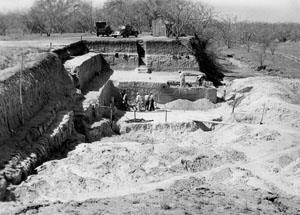
|
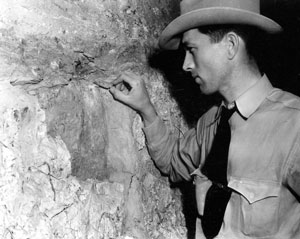
|
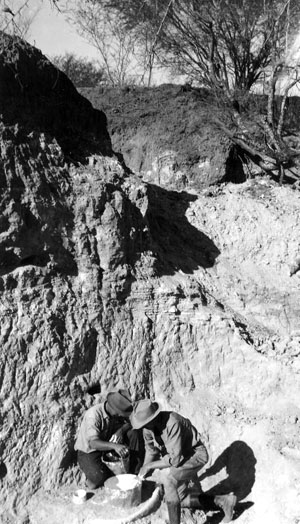
|
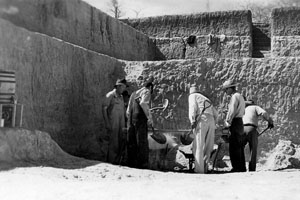
|
